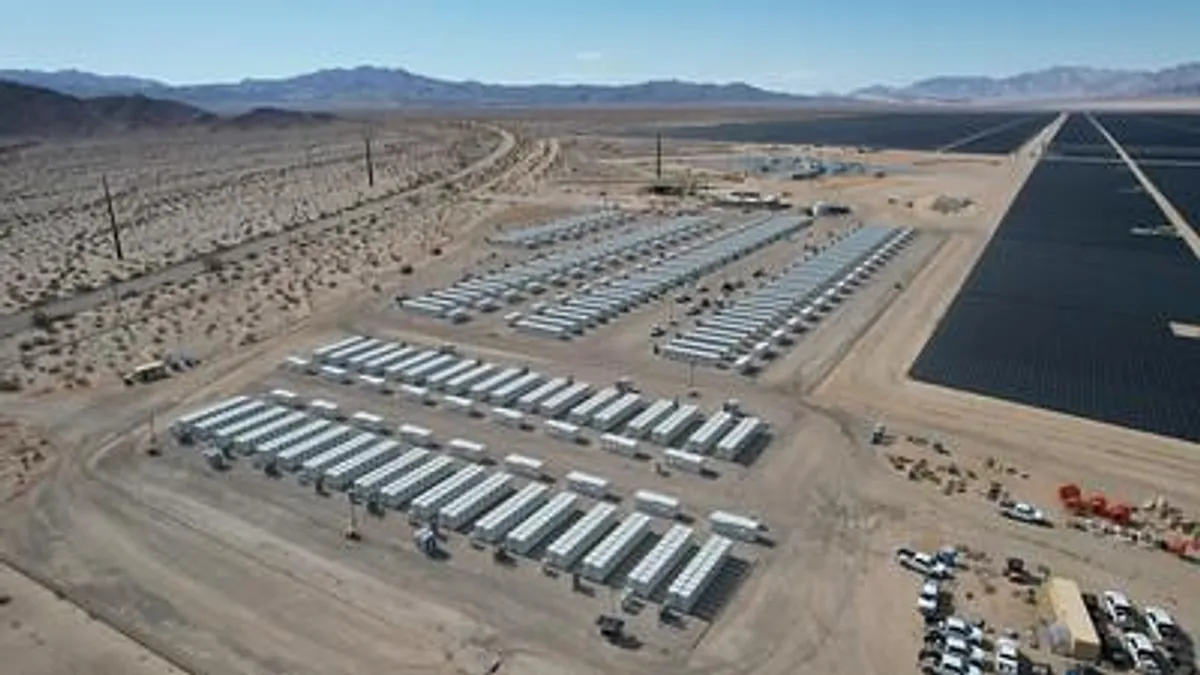Dive Brief:
- California’s energy storage portfolio could yield net grid benefits of up to $1.6 billion a year by 2032 as the state looks to expand grid-scale battery installations to 13.6 GW, according to a report put together by Lumen Energy Strategy for the California Public Utilities Commission.
- The report, a requirement included in a 2013 decision from the commission, found that California’s early-stage energy storage pilots, demonstration projects and initial procurements have “successfully enabled a scalable and cost-effective energy storage portfolio that supports the state’s statutory and policy objectives,” Lumen said in a press release.
- “A lot of these benefits come from the fact that storage – particularly well-sited storage – can provide flexible capacity and efficient reliability services to ratepayers,” Sergio Dueñas, policy manager at the California Energy Storage Alliance, said. The benefits also come from potentially deferring other investments in the electric grid and reducing greenhouse gas emissions, he added.
Dive Insight:
Lumen’s study takes a closer look at the operations, costs and benefits of storage resources in California – largely lithium-ion batteries, but also including thermal energy storage and other battery chemistries. These resources range from 25 kW to 300 MW, with discharge durations that range from less than an hour to seven hours.
The report found that from 2017 through 2021, California’s stationary storage market developed from a pilot phase into deploying lithium-ion batteries at commercial scale. At the same time, storage costs dropped significantly – with third-party contract prices ranging from $5 to $8 per kilowatt-month for capacity by the end of 2021 – and the use of storage to meet reliability needs increased significantly.
By the end of 2021, 2,200 MW/8,900 MWh of storage resources were providing resource adequacy services, according to the report. The state has since procured another 5,000 MW/20,000 MWh of storage for reliability through 2023, and a preferred system plan adopted by the CPUC in early 2022 suggests that the state will need an average build out of 1.3 GW of storage per year for reliability over the next decade.
“This study is the first I’ve seen that evaluates the benefits of energy storage resources installed at all grid locations — meaning installed at customer sites, on the distribution system, and on the transmission system — with a single consistent approach,” Mariko Geronimo Aydin, one of the co-authors of the report, said in a statement.
The study also analyzed the costs and benefits of California’s energy storage resources. From 2017 through 2021, state ratepayers invested $75 million a year on average in various exploratory storage projects and incentive programs, according to the report.
“The more recent market-mature projects reveal the first fruits of this investment: they were on track to yield net benefits at a rate of $22 million per year by the end of 2021,” it found.
Going forward, the study’s authors expect that the net grid benefits of storage will grow to potentially $835 million to $1.34 billion annually by 2032, as battery installations ramp up to 13.6 GW to meet the state’s 2021 preferred system plan. And with future policy measures to address existing and future barriers to the grid benefits offered by storage, “we believe California can secure these benefits and unlock the full potential of its energy storage portfolio: a more diversified and effective portfolio and a total net grid benefit of $1–$1.6 billion per year by 2032.”
The study doesn't assume a particular mix of technologies, but did model benefits assuming that installed storage has a four-hour duration, CPUC spokesperson Terrie Prosper said in an email. The benefits outlined in the report are primarily from providing capacity for resource adequacy, from "time-shifting" energy from low-value to high-value times, and to a lesser extent, avoiding the curtailment of renewable resources, she said.
“Customer-sited storage could also provide energy value and resource adequacy value either by reducing load (and therefore resource adequacy obligation) or when aggregated into virtual power plants, and this could potentially reduce the need to invest in grid-scale energy storage,” Prosper added.
For utility-scale resources, a key insight from this study is that lithium-ion battery technology matured to scale very quickly, and this is a model that can be replicated for other types of storage as well, Dueñas said.
On the behind-the-meter side, “I think the key takeaway is really the importance of bringing stronger grid signals to customers, so that the value of these behind-the-meter installations can also support grid needs,” he said.
The key could be finding a way to get distributed storage resources to fully provide reliability services, according to Dueñas, “because that’s where a lot of the value comes from.”














